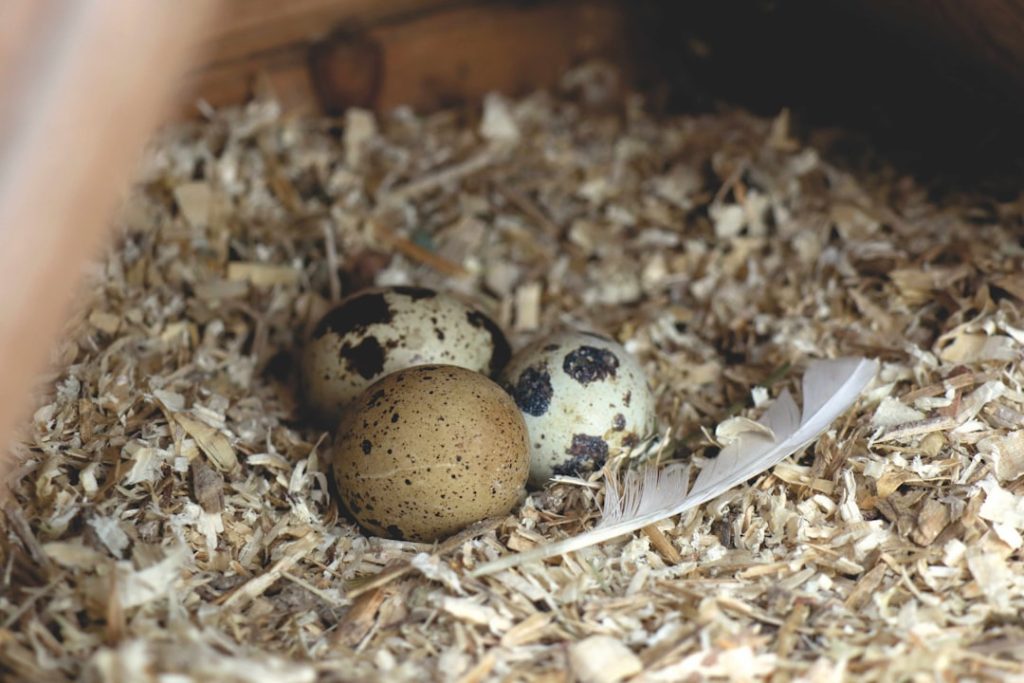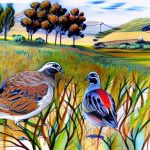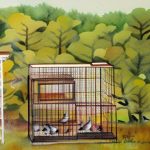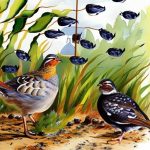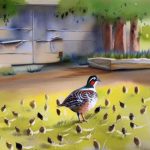Quails are small, ground-dwelling birds that are popular for their meat and eggs. Breeding quails can be a rewarding experience, but it requires a good understanding of their behavior and needs. When it comes to breeding quails, it’s important to start with a good breeding pair. A breeding pair consists of a male and a female quail that are selected for their desirable traits and genetics. The male quail, also known as a cock, is responsible for fertilizing the eggs, while the female quail, known as a hen, is responsible for laying the eggs. Understanding the behavior and characteristics of quails is essential for successful breeding. Quails are social birds that thrive in pairs or small groups, so it’s important to provide them with companionship and a suitable environment for breeding. Additionally, quails are known for their rapid growth and high egg production, making them an ideal choice for breeding purposes.
Quail breeding pairs should be selected based on their health, temperament, and genetic traits. It’s important to choose quails that are free from any genetic defects or diseases to ensure the health and vitality of the offspring. Additionally, selecting quails with desirable traits such as good egg production, strong fertility, and docile temperament can help improve the quality of the breeding pair. Understanding the genetics of quails is also important when selecting a breeding pair, as certain traits can be passed down to the offspring. By understanding the characteristics and behavior of quails, breeders can make informed decisions when selecting a breeding pair to ensure successful breeding and healthy offspring.
Table of Contents
Key Takeaways
- Understanding Quail Breeding Pair:
- Quail breeding pairs consist of one male and multiple females.
- They are monogamous and will mate for life.
- The male is responsible for protecting the females and mating with them.
- Selecting the Right Quail Breeding Pair:
- Choose healthy, disease-free birds with good genetics.
- Look for birds that are of the same age and size for optimal breeding success.
- Consider the temperament and behavior of the birds when selecting a breeding pair.
- Housing and Nesting for Quail Breeding Pair:
- Provide a spacious and secure enclosure with separate nesting areas for each female.
- Use nesting materials such as straw or hay to create comfortable and safe nesting spaces.
- Ensure the enclosure has proper ventilation and protection from predators.
- Feeding and Nutrition for Quail Breeding Pair:
- Offer a balanced diet of high-quality quail feed, supplemented with fresh greens and protein sources.
- Provide access to clean water at all times, especially during breeding and egg-laying periods.
- Monitor the birds’ body condition and adjust their diet as needed.
- Breeding and Incubation Process for Quail Breeding Pair:
- Allow the male to mate with the females, and collect the eggs for incubation.
- Use an appropriate incubator to hatch the eggs, maintaining proper temperature and humidity levels.
- Carefully monitor the hatching process and provide proper care for the chicks after they hatch.
- Health and Care for Quail Breeding Pair:
- Regularly check the birds for signs of illness or injury, and seek veterinary care when needed.
- Keep the enclosure clean and provide a stress-free environment for the birds.
- Handle the birds gently and minimize disturbances to reduce stress.
- Selling and Marketing Quail Breeding Pair:
- Advertise the availability of quail breeding pairs through online platforms, local markets, and social media.
- Provide potential buyers with information about the birds’ health, genetics, and breeding history.
- Offer support and guidance to new quail breeders to ensure the success of the breeding pairs in their new homes.
Selecting the Right Quail Breeding Pair
Selecting the right quail breeding pair is crucial for successful breeding and healthy offspring. When choosing a breeding pair, it’s important to consider factors such as age, health, genetics, and temperament. Quails reach sexual maturity at around 6-8 weeks of age, so it’s important to select breeding pairs that are at least this age to ensure they are ready for breeding. Additionally, both the male and female quail should be in good health with no signs of illness or genetic defects. This can be determined by observing their behavior, physical appearance, and overall condition. It’s also important to consider the genetics of the quails when selecting a breeding pair. By choosing quails with desirable traits such as high egg production, strong fertility, and good temperament, breeders can improve the quality of the breeding pair and the offspring.
Temperament is another important factor to consider when selecting a breeding pair. Quails with a docile and non-aggressive temperament are ideal for breeding, as they are less likely to exhibit aggressive behavior towards each other or their offspring. This can help create a harmonious environment for breeding and raising the young quails. When selecting a breeding pair, it’s important to observe their behavior and interactions with each other to ensure they are compatible and well-suited for breeding. By carefully considering factors such as age, health, genetics, and temperament, breeders can select the right quail breeding pair for successful breeding and healthy offspring.
Housing and Nesting for Quail Breeding Pair
Proper housing and nesting are essential for providing a suitable environment for quail breeding pairs. Quails are ground-dwelling birds that require a spacious and secure enclosure to thrive and breed successfully. When housing a quail breeding pair, it’s important to provide them with a clean and well-ventilated coop or aviary that offers protection from predators and the elements. The enclosure should be spacious enough to allow the quails to move around freely and engage in natural behaviors such as dust bathing and foraging. Additionally, providing suitable nesting areas is crucial for encouraging breeding behavior in quails. Nesting boxes or areas should be provided within the enclosure to give the quails a safe and comfortable space to lay their eggs.
The nesting area should be filled with clean bedding material such as straw or wood shavings to provide a soft and cozy environment for the quails to lay their eggs. It’s important to regularly clean and maintain the nesting area to ensure it remains hygienic and free from parasites or bacteria that could affect the health of the quails and their offspring. By providing a suitable housing and nesting environment, breeders can create an ideal setting for quail breeding pairs to thrive and produce healthy offspring.
Feeding and Nutrition for Quail Breeding Pair
Feeding and nutrition play a crucial role in the health and reproductive success of quail breeding pairs. Providing a balanced diet that meets the nutritional needs of the quails is essential for ensuring they are in optimal condition for breeding and producing healthy offspring. Quails require a diet that is high in protein to support their rapid growth and egg production. A commercial game bird feed or turkey starter feed is an ideal option for providing the necessary protein and nutrients for quail breeding pairs. Additionally, supplementing their diet with fresh fruits, vegetables, and mealworms can provide additional vitamins and minerals to support their overall health and reproductive function.
It’s important to provide access to clean water at all times to ensure the quails remain hydrated and healthy. Water is essential for egg production and overall health, so it’s important to regularly check and refill their water containers to prevent dehydration. Additionally, providing access to grit or crushed oyster shells can help support the digestive health of the quails and provide essential calcium for strong eggshells. By ensuring quail breeding pairs receive a balanced diet that meets their nutritional needs, breeders can support their reproductive success and the health of their offspring.
Breeding and Incubation Process for Quail Breeding Pair
Breeding and incubating quail eggs requires careful planning and attention to detail to ensure successful hatching and healthy offspring. When it comes to breeding quails, it’s important to provide a suitable environment that encourages natural mating behavior between the breeding pair. Observing the behavior of the quails can help determine when they are ready to breed, as males will often display courtship behavior towards females by puffing up their feathers and making vocalizations. Once mating has occurred, it’s important to collect the eggs promptly to prevent them from being damaged or eaten by the quails.
Incubating quail eggs requires a specialized incubator that provides consistent temperature and humidity levels to support embryo development. Quail eggs typically require an incubation period of 17-18 days before hatching, so it’s important to carefully monitor the temperature and humidity levels throughout the incubation process. Turning the eggs several times a day can help ensure proper development and prevent the embryos from sticking to the shell membrane. Additionally, maintaining a clean and hygienic environment within the incubator is essential for preventing bacterial contamination that could affect the viability of the eggs. By following proper breeding and incubation practices, breeders can increase the likelihood of successful hatching and produce healthy quail offspring.
Health and Care for Quail Breeding Pair
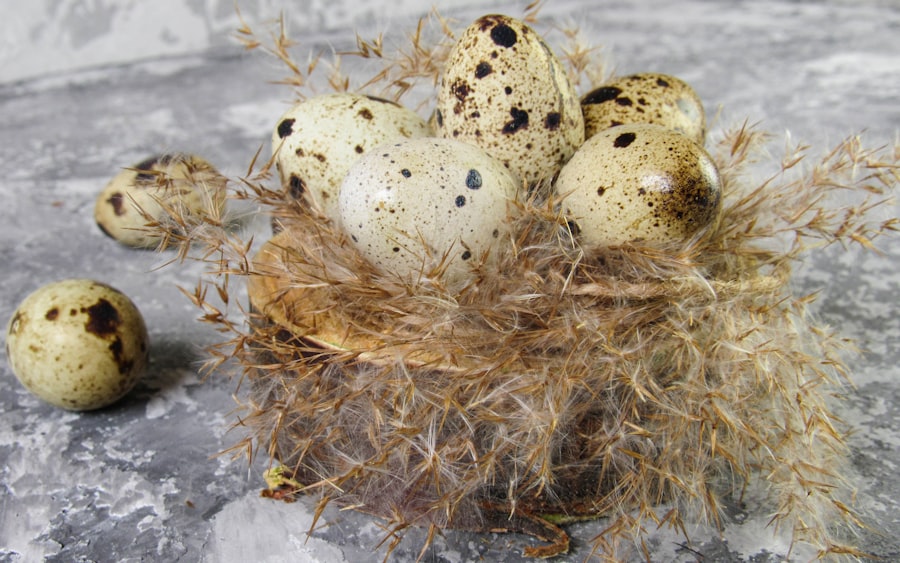
Maintaining the health and well-being of quail breeding pairs is essential for successful breeding and producing healthy offspring. Regular health checks should be conducted to monitor the condition of the quails and identify any signs of illness or injury. It’s important to observe their behavior, physical appearance, and overall condition to ensure they are in good health. Additionally, providing a clean and hygienic environment within their enclosure can help prevent the spread of disease and parasites that could affect the quails’ health.
Quail breeding pairs should be provided with regular access to dust baths to help keep their feathers clean and free from parasites. Dust bathing is a natural behavior for quails that helps maintain their feather condition and remove any parasites or debris from their plumage. Additionally, providing access to perches or platforms within their enclosure can help prevent foot injuries and encourage natural behaviors such as roosting. By providing proper care and attention to the health of quail breeding pairs, breeders can ensure they are in optimal condition for successful breeding and producing healthy offspring.
Selling and Marketing Quail Breeding Pair
Once quail breeding pairs have successfully produced offspring, breeders may choose to sell them to other enthusiasts or individuals interested in raising quails. Marketing quail breeding pairs can be done through various channels such as online classifieds, social media platforms, or local agricultural fairs and events. When marketing quail breeding pairs, it’s important to highlight their desirable traits such as high egg production, strong fertility, and good temperament.
Providing potential buyers with information about the genetics and lineage of the quails can also help demonstrate their quality and potential for producing healthy offspring. Additionally, offering support and guidance to new owners on how to care for and breed quails can help build trust and confidence in the quality of the breeding pairs being sold. By effectively marketing quail breeding pairs, breeders can find suitable homes for their offspring while also promoting responsible quail breeding practices within the community.
In conclusion, breeding quails can be a rewarding experience that requires careful planning, attention to detail, and a good understanding of their behavior and needs. Selecting the right quail breeding pair is crucial for successful breeding and producing healthy offspring. Providing proper housing, nesting areas, feeding, incubation, health care, and marketing strategies can help ensure the success of quail breeding pairs while promoting responsible breeding practices within the community.
If you’re interested in quail breeding, you may also want to check out this informative article on how to care for goslings. It provides valuable insights into raising and nurturing young geese, which can be helpful for those looking to expand their poultry breeding endeavors. You can find the article here.
FAQs
What is a quail breeding pair?
A quail breeding pair refers to a male and female quail that are kept together for the purpose of breeding and producing offspring.
How do you identify a quail breeding pair?
Male quails, also known as cocks, can be identified by their distinctive plumage and vocalizations. Female quails, also known as hens, are usually smaller and have more subdued plumage compared to males.
What is the breeding season for quails?
Quails typically breed during the spring and summer months when the weather is warmer and food sources are more abundant. However, with proper care and conditions, quails can breed throughout the year.
How do you care for a quail breeding pair?
Quail breeding pairs should be provided with a suitable enclosure that offers protection from predators and the elements. They should also be given a balanced diet that includes a variety of seeds, grains, and insects. Additionally, providing nesting materials and a quiet, secluded area for the female to lay her eggs is important.
How many eggs can a quail breeding pair produce?
A healthy quail breeding pair can produce a significant number of eggs, with some breeds laying up to 300 eggs per year. The number of eggs produced will depend on factors such as the breed of quail, age, and overall health of the birds.
What should I do with the quail eggs produced by a breeding pair?
Quail eggs produced by a breeding pair can be used for hatching new chicks, consumed as a nutritious food source, or sold for profit. Proper handling and storage of quail eggs is important to maintain their freshness and viability.
Meet Walter, the feathered-friend fanatic of Florida! Nestled in the sunshine state, Walter struts through life with his feathered companions, clucking his way to happiness. With a coop that’s fancier than a five-star hotel, he’s the Don Juan of the chicken world. When he’s not teaching his hens to do the cha-cha, you’ll find him in a heated debate with his prized rooster, Sir Clucks-a-Lot. Walter’s poultry passion is no yolk; he’s the sunny-side-up guy you never knew you needed in your flock of friends!

